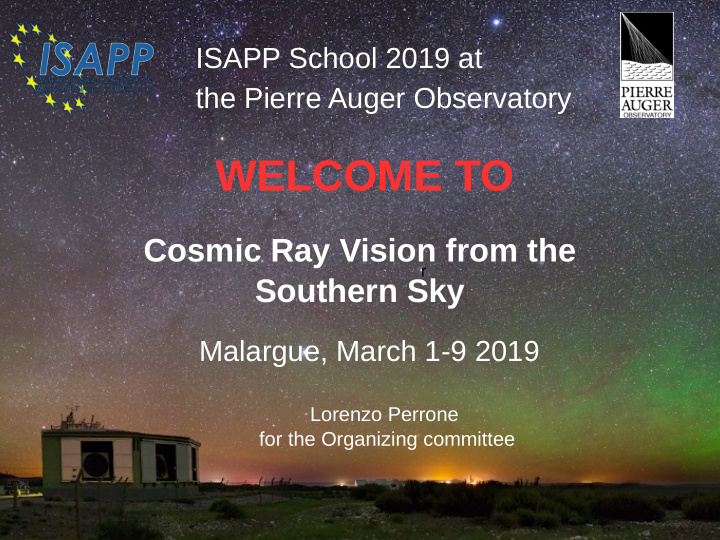



ISAPP School 2019 at the Pierre Auger Observatory WELCOME TO Cosmic Ray Vision from the r Southern Sky Malargue, March 1-9 2019 Lorenzo Perrone for the Organizing committee
How and why this doctorate school edition is conceived ISAPP and The Pierre Auger Observatory joint effort - facilitate the participation from Latin American countries - encourage the exchange between students on large scale - profit from the unique location “This initiative is supported by the International School on Astroparticle Physics (ISAPP https://www.isapp-schools.org/), a network including 39 institutions and doctorate schools which has the mission of disseminating Astroparticle Physics, training the future community of scientists in the field and encouraging exchanges of students. This current edition is also supported by the Pierre Auger Observatory with the aim of facilitating and promoting the participation of students from Latin- American countries”
https://www.isapp-schools.org/
https://www.isapp-schools.org/
School topics “School topics will include UHE cosmic rays, cosmic ray sources and propagation, high- energy neutrinos, gamma rays and multi-messenger astronomy. Regular lectures will be given in the mornings and topic seminars about selected experiments in the afternoons. In the spirit of the ISAPP schools, lectures will be complemented by extensive exercises.”
School Website http://indico.nucleares.unam.mx/e/isapp2019
LOC and IAC IAC Antonio Bueno, Francis Halzen, Karl-Heinz Kampert, Rene A. Ong, Alan A. Watson And the ISAPP steering committee [https://www.isapp-schools.org/steering-committee] LOC Lorenzo Perrone (chair), Ingo Allekotte, Gualberto Avila, Antonella Castellina, Ralph Engel, Jörg R. Hörandel, Lukas Nellen, Mario Pimenta, Miguel-A Sanchez-Conde, Viviana Scherini, Tiina Suomijärvi, Enrique Zas Secretariat Rosa Pacheco (Pierre Auger Observatory), Lucia Sideli and Carla Gentile (INFN, Lecce)
The Agenda in one shot SIDE ACTIVITIES FORMAT Interaction with the Observatory staff - Lectures with exercises Excursion and night sky observation (6/3) AND Visit to the field (7/3) - Seminars on specific items Participating to a FD shift (7/3) - Public lecture (3/3) Hands-on session (9/3) - Poster Session (5/3) Lectures E Hands on Seminars x session c AUGER u day r s Poster Poster i Public session awards lecture o Meeting the Observatory n
Location Convention and Exhibition Center Thesaurus Pierre Auger Observatory headquarter “Office building” Thesaurus Right across the street from the Pierre Auger Observatory headquarter “Office building”
WI-FI Connections Connection at Thesaurus, Red room (network id: Isapp auger passwd:estudiantes2019) Open connection available at the Observatory headquarter Proxy needed in most cases (some smart-phones working also without) Please, configure your network settings as in the example
Where will the sessions be held? Convention and Exhibition Center Thesaurus Red Room : seminars and public lecture Yellow room : lectures COFFEE BREAK area
Posters Posters can be hung along the main corridor of the convention center. Panels are already available Session poster is scheduled on March 5 th , at 3.30 pm Best poster award (talk) on March 8 th at 5:30 pm.
Public lecture on Sun March 3 9:30 pm Prof. Miguel Mostafa Penn State University USA Las partículas más energéticas del universo ¡Las partículas conocidas como rayos cósmicos nos bombardean constantemente! Uno de los mayores misterios en astrofísica es el origen de los rayos cósmicos de más alta energía en el universo. Estos rayos cósmicos son los que detectamos con el Observatorio Pierre Auger. Son extremadamente exóticos (¡e interesantes!) porque cada uno de ellos tiene una energía que es millones de veces más alta que la energía de las partículas aceleradas por el Gran Colisionador de Hadrones, el acelerador de partículas más poderoso del mundo. En esta charla entre amigos vamos a discutir una pregunta muy importante que se hacen todos los habitantes de Malargüe. ¿Qué hacen los científicos del Pierre Auger? Y más importante aún, ¿para qué sirve todo esto?
Excursion on Wed March 6 th : Castillo de Pincheira Departure: 11:30 from Thesaurus , after coffee-break Transport by bus (27 km from Malargue) ASADO since 1 pm Hiking in the afternoon Light dinner at about 8 pm Night sky observations since 9:30 pm together with Andrés Risi (Planetarium of Malargue) Return to Malargue at about 11 pm Recommendations: sun screen for the day warm clothes for the evening
Visit to the field on Thu March 7 th Departure: 2 pm from Thesaurus, lunch boxes served along the trip Visit to the FD site at Coihueco (~ 40 km from Malargue) Fluorescence detector (Coihueco and HEAT Building) Visit to the SD and SSD site in the field close to “El Sosneado” (~ 50 km from Malargue) Return to Malargue at about 7:30 pm Surface detector and upgrade
Participation in the night shift on Thu March 7 th
Hands-on session on March 9 th Subject: The life of a cosmic ray from source to detector Source→ Propagation→ Air shower generation→ Detection Self-managed session with guidance, profiting from your experience and expertise offered to the other participants. Laptop recommended
We got patronage and support from the city of Malargue Thanks! Wide advertisement for the school and for the public lecture TV/ Radio interviews Connection to the city very important
MAP of the city Surroundings Please, have a look at the fliers you received in the school bag and in particular read the safety recommendations. More info available in the school website.
Acknowledgements - ISAPP Network - The Pierre Auger Observatory: in particular, Ingo Allekotte, Gualberto Avila, Rosa Pacheco - INFN Lecce for providing the support of one person in situ (Lucia Sideli) - All the contributing Countries - All speakers that accepted to contribute to this experience. THANK YOU FOR PARTICIPATING IN THIS INITIATIVE Don’t hesitate to contact me or the school secretariat or any member of the Observatory for questions or support
Recommend
More recommend